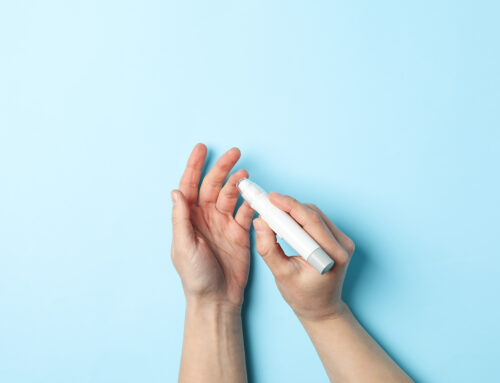Not catching enough z’s? You’re not alone. One in seven adults have chronic insomnia. Thyroid issues, hypoglycemia, parasites, leaky gut and other imbalances in the body can keep you from restorative sleep.
No matter what conditions sit at the root cause of your sleep problems, you can benefit from these 10 steps to a better sleep routine.
What you do or don’t do before bed can dramatically affect sleep quality. Find ways to improve your sleep hygiene. Pick out a few to start using tonight to help beat insomnia.
1. Set a new alarm
First things, first: get out your alarm clock. We’re not talking for the morning, here. The first step to a better sleep routine involves setting a new alarm.
Program your phone or clock to go off an hour or two before bed. This serves as a signal to yourself that it’s time to unwind. Once the alarm goes off, put away the work and worries of the day. Focus on relaxation. True, this can be hard when there are projects left undone. You may need to remind yourself that your number one job at this point in the evening is to prepare your body for rest.
Create an anchoring habit. As soon as the alarm goes off, begin warming the kettle for herbal tea. Use the heating time to put away any physical clutter around your living space. You’ll be setting the stage to clear mental clutter, too.
2. Take a warm shower or bath
Next, stress-reduction takes center stage when creating a better sleep routine,. To help melt away stress, consider using a ½ cup of epsom salt in the tub to get a dose of sleep-enhancing magnesium. You can add in a few drops of lavender essential oil, as well. Alternatively, get out a diffuser and create your own relaxing blend of aromatherapy.
3. Stay on schedule
Third, when adjusting your sleep routine, you’ll need to think about your ideal schedule. Waking up and going to sleep at the same time each day can promote better sleep. Prepare your body for sleep and entrain these circadian rhythms by being consistent.
4. Center yourself
Fourth, find ways to recenter yourself. Stop ruminating thoughts in their tracks. Discover what helps you distance yourself mentally from the day’s to-do list and recenter. Try a gratitude journal, meditation or prayer. You may find that relaxing music helps you unwind in the hours leading up to bed. Instrumental piano, classical or anything soothing can help prepare your mind and body for bed.
5. Embrace the darkside
Fifth, when taking steps towards a better sleep routine, darkness is key. A dark room promotes sleep. Consider investing in room-darkening blinds. Gotta go to the bathroom during the night? Be sure there’s a clear path so you can get up without turning on any lights. Even the smallest amounts of lights can disrupt your ability to return to sleep.
If traveling, pack a roll of electrical tape to cover the array of tiny lights on TV’s, smoke detectors and other electronics.
6. Try blue-blocking
Sixth, say goodnight to your electronics. Avoid looking at screens from TV’s, phones, tablets and computers for the three hours before bed. If you must use a screen then, wear blue-blocking glasses. Blue light suppresses sleep-inducing melatonin. Swap your bedside lamps’ standard LED light bulbs for amber bulbs or ones labeled as blue-blocking.
7. The time is right
Seventh, go to bed when melatonin production is highest–between 9:00 p.m. and midnight. If you must nap during the day, keep it under 20 minutes. Limit caffeine-containing beverages in the afternoon. Know that while alcohol may make you feel sleepy at first, it can prevent you from entering deep REM sleep.
8. Balance blood sugar
The eighth step to better sleep centers around blood sugar. What you eat during the day could have an affect on your sleep at night. Opt for fare full of healthy fat and protein to keep blood sugar levels steady any time of day.
Hypoglycemia waking you? Keep a protein-rich snacks like a handful of almonds or a hard-boiled egg on your nightstand if you tend to wake up in a panic.
9. Frame of mind
One of the most important steps in creating a better sleep routine is all in your head. Our thoughts are powerful, physical structures in our brains. What we think, our bodies like to do. Don’t entertain thoughts of doubt or worry about being able to fall or stay asleep. If you visualize yourself tossing and turning, don’t be surprised if your body follows suit.
If you find yourself tripping back into a negative mindset remember these three steps: stop, breathe, reset. First, stop and tell your inner Negative Nancy to take a hike. Second, take a few deep breaths, with air going in through your nostrils slowly and out through your mouth in a steady stream. Third, reset by changing the script. Fill your mind with positive images of effortless, restorative sleep. If you still find yourself gravitating to negative thoughts, download a mediation app that features a body scan meditation. Meditations for sleep help focus attention, quiet your mind and relax, head to toe.
10. Sleep sanctuary
Lastly, commit to making your bedroom a place for sleep and sex only. Keep laptops and work files far away from your sleep sanctuary.
Also, consider the effect noise and temperature may be playing in how well you are sleeping. Trying setting the thermostat between 60 and 67 degrees Fahrenheit.
Similarly, investigate the role noise level may be playing in how easily you snooze. While some people may be lulled to sleep by the sound of an overhead fan, others may find it distracting. Work with your partner to find an ideal sleeping environment for both of you.
Tried it all and still feel stuck? Have a hunch your thyroid is to blame but ya haven’t found the answers yet? You’re not alone. That’s why we created our Thyroid M.V.P. Program – Measurable, Verifiable, Progress™. Get the answers in this all-inclusive program, including lab work from a LabCorp lab near you. Why wait to get to the root cause of your health problems? Book your free 30 minute consultation call now. Start feeling like yourself again.





